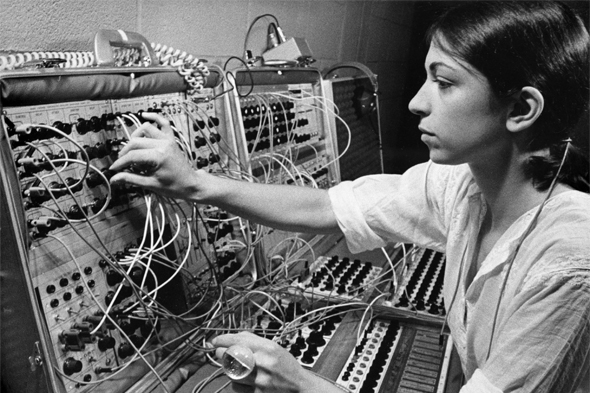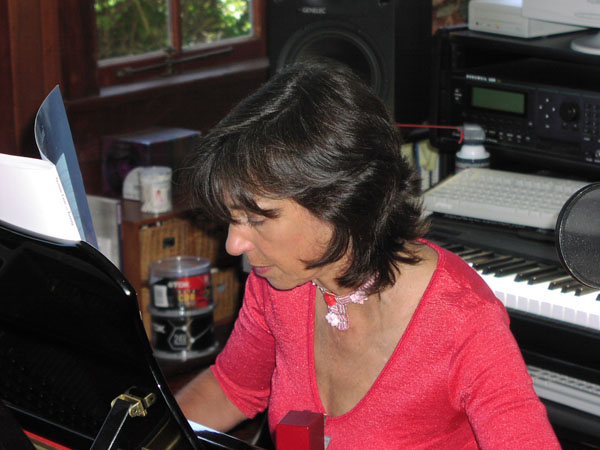Suzanne Ciani's Electronic World Circa 1975
Written by John Diliberto on August 1st, 2016
Suzanne Ciani has been a guest on Echoes many times, playing live twice and giving several interviews. In 2002 I talked about her early days at Mills College, home of the west coast avant-garde scene. To illustrate the music she was making then, she sent me a reel-to-reel tape of her Buchla performance at New York radio station WBAI in 1975. We included the tape in a segment of the feature, but when Ciani heard it she called us up to say we’d played it wrong.
She had sent us a quarter-track tape, meant to be played on a quarter-track tape machine that was the consumer version of reel-to-reel recorders. Instead of two stereo tracks, there were four, a pair going in each direction so when you played the tape through, it would play one pair of stereo tracks and when you got to the end, you’d flip it back on the supply reel and it would play the other pair of stereo tracks, much like playing a cassette and flipping it over. However, even at that early date, I hadn’t run across a quarter-track tape in two decades, so I just assumed it was a regular two-track tape and we played it on a professional half-track tape machine. That meant that all four tracks played simultaneously. You heard one stereo pair going forward and one played backward. It was pretty avant-garde music to start with, so there was no way we’d know it wasn’t supposed to sound like that. We were appalled at our error but Ciani was laughing her head off. She thought it was a riot. At least we played it at the right speed.
Now, 14 years later, I’m listening to Suzanne Ciani’s new album of old music, Buchla Concerts 1975. For those who came to Suzanne Ciani with her albums on Finnadar, RCA, Private Music and elsewhere, this may be something of a shock. She’s not evoking affairs of the heart, sojourns to Italy or easy-listening moods. There are no sweet melodies and harmonies here. Instead there are swirls and spirals of notes, circuit breaker dissonance and alien rhythmic patterns. Ciani brings it all together in non-stop flowing, partly improvised performances.
This music is drawn from two live concerts in 1975. One at the WBAI Free Music Store, a radio show on WBAI FM. The other from a concert at Phil Niblock’s Loft. Niblock himself was a downtown avant-garde composer of note.
 The music is all played on the Buchla 200 Synthesizer. At the time, most of us in electronic music still thought that Buchla was the west coast equivalent of the Moog. But unlike the Moog, the Buchla never caught on in pop music, yet it was a favorite of avant-garde composers like Morton Subotnick. But similar to the Moog, there was no memory. You had to build the instrument up from zero, creating sounds, patterns, envelopes, etc. with patch cords and switches. And unlike the Moog, there was no conventional keyboard. Donald Buchla originally wanted no controller at all, but he reluctantly conceded to a flat metal touch plate with faux piano keys etched into its surface. Playing it live was a challenge. Each concert is distinctly different. The WBAI show is an excursion into chaotic space. The Niblock’s Loft performance starts with an almost fugue like melody that slowly, though not minimally, morphs. It’s an enveloping experience, but not a conventional one, especially in 1975. If you compare to electronic works at the time, it was far more abstract than Tangerine Dream’s live Ricochet album, and less structured, though timbrally similar to Morton Subotnick’s Until Spring, both albums released in 1975.
The music is all played on the Buchla 200 Synthesizer. At the time, most of us in electronic music still thought that Buchla was the west coast equivalent of the Moog. But unlike the Moog, the Buchla never caught on in pop music, yet it was a favorite of avant-garde composers like Morton Subotnick. But similar to the Moog, there was no memory. You had to build the instrument up from zero, creating sounds, patterns, envelopes, etc. with patch cords and switches. And unlike the Moog, there was no conventional keyboard. Donald Buchla originally wanted no controller at all, but he reluctantly conceded to a flat metal touch plate with faux piano keys etched into its surface. Playing it live was a challenge. Each concert is distinctly different. The WBAI show is an excursion into chaotic space. The Niblock’s Loft performance starts with an almost fugue like melody that slowly, though not minimally, morphs. It’s an enveloping experience, but not a conventional one, especially in 1975. If you compare to electronic works at the time, it was far more abstract than Tangerine Dream’s live Ricochet album, and less structured, though timbrally similar to Morton Subotnick’s Until Spring, both albums released in 1975.
Truthfully, it’s much better hearing it as just two stereo tracks going the right way while Ciani orchestrates a three-dimensional electronic space in real time. Apparently, the album is only available on vinyl from Finders Keepers Records. It takes me back, not only with the old Buchla analog synthesizer sounds, but the scratches on the virgin record that aren’t there for effect. Ahh, the good old days of pristine music heard through the potholes of clicks and pops. Silly vinyl fetishists.

